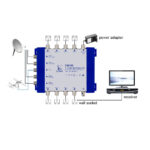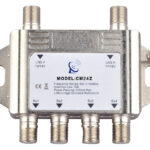What is Satellite Television? & How does it Work?
The transmission of radio and television signals, whether digital or analogue, is carried by terrestrial, cable or satellite.
Terrestrial television or over-the-air television (OTA) is a type of television broadcasting in which the signal is transmitted by radio waves from a television station’s terrestrial (earth-based) transmitter to a television receiver with an antenna.
The original trolley antenna we all use on our TVs or the fishbone antenna we set up outside is this type of transmission. This type of transmission requires a tower antenna set up by the radio and television department, or a microwave antenna with a certain coverage radius, just like a mobile communication base station.
Cable television is a system that delivers television programmes to consumers by transmitting radio frequency (RF) signals over coaxial cables or, in more recent systems, optical pulses over fibre optic cables.
Satellite television is a service that delivers television programmes to viewers by relaying them directly to their location from a communications satellite in Earth’s orbit. It uses a pot surface antenna to receive satellite signals, which are decoded by a satellite receiver and fed to a TV set.
Each of the three transmission methods has its advantages and disadvantages, but satellite transmission is the most competitive one compared to the other two.
Where do the signals received by the satellite TV system come from?
The television signals we receive are transmitted directly from satellites in geostationary orbit. This satellite orbits 36,000 km above the earth’s equator in a large circular orbit. One of its most important features is that its orbital period is strictly the same as the earth’s autobiographical period and its orbit is fixed over the equator. In other words, this satellite is stationary around the Earth.
The orbits are assigned by the International Telecommunication Union (ITU) according to regional and national factors, and there are approximately 180 satellites in geosynchronous orbit.
When you look at the satellite position parameters, you only see the satellite’s longitude value, such as how many degrees east (EXXX), or how many degrees west (WXXX), because the satellite’s position is only fixed directly above the equator, the latitude value is always 0 degrees, using only the longitude value, you can mark its position. And different satellites relay different programmes and cover different areas.
Where do the signals from the satellites come from?
The satellite itself does not produce TV signals, it is the ground-based broadcasting satellite uplink station that transmits TV signals to the satellite, and after the satellite receives them, it uses the energy generated by the solar cells it carries to amplify and process the TV signals before forwarding them to Earth, the satellite only plays a signal relay role.
Satellite TV reception system composition
The satellite TV reception system on the ground is composed of: a parabolic antenna, feed source, HF head and satellite receiver.
1, the parabolic antenna is to reflect the satellite signal energy from the stars to converge into a focal point.
2, the feed source is set at the focal point of the parabolic antenna to gather the satellite signal horn, called feed source means feed energy source, it will converge to the focal point of all the energy collected.
3, high-frequency head (LNB also known as frequency reducer) is the satellite signal sent from the feed source for frequency reduction and signal amplification, and then transmitted to the satellite receiver. The lower the noise level of the HF head, the better.
4, the satellite receiver is the satellite signal from the HF head for demodulation, the output satellite TV image signal and the accompanying sound signal.
What is a satellite antenna?
A satellite antenna is a metal parabolic antenna. All parabolas have a focal point and the main axis. According to the principle of reflection, the rays emitted from the focal point are emitted parallel to the main axis; similarly, the rays coming in parallel to the main axis converge on the focal point.
Radio wave signals from space (which can simply be seen as parallel signals), which are weak due to the distance, can be collected by the parabolic antenna in sufficient numbers to be brought together and fed to the HF head.
The larger the diameter of the opening of the satellite pot, the stronger the signal of the programme and the higher the reception quality. However, given the cost, installation and other factors, users require the smaller the diameter of the satellite pot, the better. How do you measure what kind of satellite pot to install?
Satellite antennas can be divided into two types: positive-fed and partial-fed.
The positive-fed antenna is formed by cutting a straight line perpendicular to the central axis of the parabola, which has a large reflective surface area (those with an opening diameter of 1.2m or more are basically positive-fed antennas), so they are commonly known as “big pots” and are usually used to receive C-band programmes.
The partial-feed antenna is part of the interception from the positive-feed antenna, its paraboloid is still the original paraboloid, and the focus is still the original focus, but, compared to the antenna, the focus is no longer in front of the antenna, so the receiver feed source will not block the signal, which improves the efficiency of the antenna.
The partial-feed antenna reflective surface area is relatively small (diameter in 1 m or less, all bias-fed antenna), called “small pot” or “small ears”, mainly to receive Ku-band programs.
How do achieve “One antenna, Multiple satellites”?
We usually receive TV signals from a single dish with an LNB and an antenna aimed at a single satellite, which can only receive signals from one satellite. However, the “One antenna, Multiple satellites” can be used to receive signals from multiple satellites with one antenna and multiple LNBs.
This is because the satellite antenna is concave and when it is aimed at a satellite in the sky, the signals from other satellites in the vicinity are also reflected and converged, just not in the main focus, and these scattered signals can be collected and transmitted to the LNB as long as they are strong enough to receive the programme.
What is the difference between C-band and KU-band?
When a new broadcast synchronous satellite is launched, we often see in the media presentations information about how many degrees east or west longitude it is positioned at, how many C-band transponders, how many KU-band transponders, how many programmes it can relay, what areas it covers, where it broadcasts to, etc.
So what do C-band transponders and KU-band transponders refer to and what exactly is the difference between them?
As we all know, whether the signal is received by radio or satellite, it is carried by radio waves, and an important parameter of radio waves is the frequency, and it is the difference in frequency that divides what we call C-band and KU-band.
The ITU divides the downlink frequency of broadcasting satellites into a C-band downlink frequency of 3.4-4.2GHZ, a KU-band frequency of 11.7-12.75GHZ, and now the reception of civil broadcasting satellites is limited to these two bands.
KU band in the rain and snow, the signal will have a certain attenuation, the impact on the reception; while the C band by the weather factors will be less affected, so in the tropical rainforest areas, the climate of the region, the application is very widespread.
Ku antennas, commonly used specifications are 0.35, 0.45, 0.6, 0.75, 0.8, 0.9, 1.0, 1.2, 1.5 meters, etc., can fully meet the needs of individuals, cable TV stations and “village” projects.
The C-band antenna has various specifications such as an opening diameter of 1.35, 1.5, 1.8, 2.1, 2.4m, etc. These specifications can fully meet the needs of receiving all domestic channels as well as international famous channels such as Phoenix TV, CNN, BBC, NHK, etc. in the high latitude northeast region.
There are usually a dozen or even dozens of transponders on a synchronous communication satellite (e.g. ChinaSat 9, with 4 x 54MHz + 18 x 36MHz all 22 KU-band transponders), each transponder has a certain bandwidth, such as 27MHZ, 36MHZ, 54MHZ (mostly multiples of 9), and generally, one transponder can relay 4-8 sets of programmes.
We can imagine the transponder as a highway with a fixed width, but nowadays almost all satellites have adopted digital technology to digitally compress the transmitted programmes, which greatly saves the bandwidth occupied by each programme and improves the utilisation rate of the transponder, making the transmitted programme capacity much higher.
Each transponder has a different number or name, and the range of a satellite’s C-band transponder or KU-band transponder for terrestrial broadcasting is called the beam coverage of that band.
Transponders can be owned by different media companies or groups, who buy or lease them from the satellite’s owner to enable the broadcast of programmes in a specific area. For example, CCTV’s uplink programmes on ChinaSat 6B are broadcast nationwide via two transponders, S7 and S9.
What is the LNB?
Radio and television signals are broadcast to the ground via satellite carriers, both in the C-band for carrier broadcasting and in the KU-band for carrier broadcasting.
When we receive on the ground, the receiver (LNB) used is also divided into two categories: if you receive KU-band programmes, you should use the KU-band LNB, and if you receive C-band programmes, you should use the C-band LNB.
If you want to receive C-band and KU-band programmes on the same satellite and use one antenna, then a composite LNB is used.
The LNB is responsible for receiving the signals converged from the satellite pot antenna, but the strength of the signals received is still far from being sent directly to the receiver for processing, so the LNB has two roles.
One is to transmit from space up to a few GHz C-band signals or even a dozen GHz Ku-band high-frequency satellite carrier signals into 1GHZ or so medium-frequency carrier signals.
The second is the amplification of the signal. The amplification mentioned here refers to the amplification of two processes: the high-frequency amplification before the frequency reduction and the medium-frequency amplification after the frequency reduction.
The signal processing process of the LNB is low noise high-frequency amplification – → low noise frequency reduction – → low noise medium frequency amplification – → output to the receiver. The entire signal processing process requires noise reduction and interference reduction, hence the “low noise” in the name of the LNB.
After reading the above introduction, you would have a certain understanding of satellite TV reception systems. Please contact us through the CONTACT page or by email if you have any questions.




